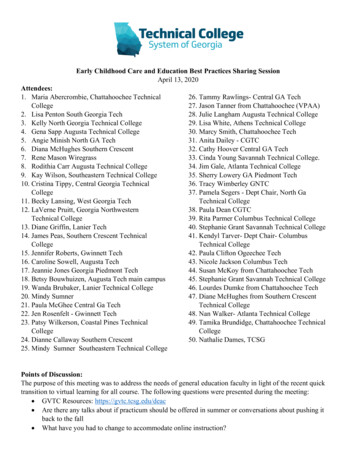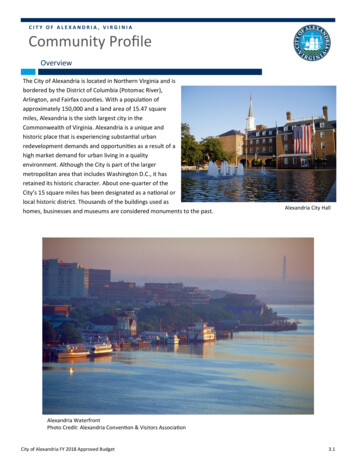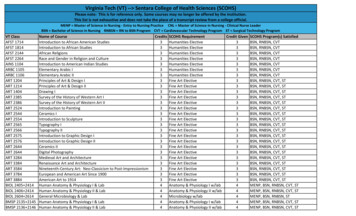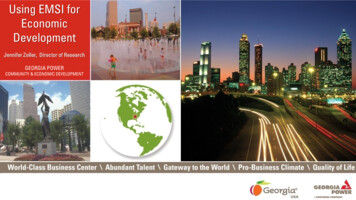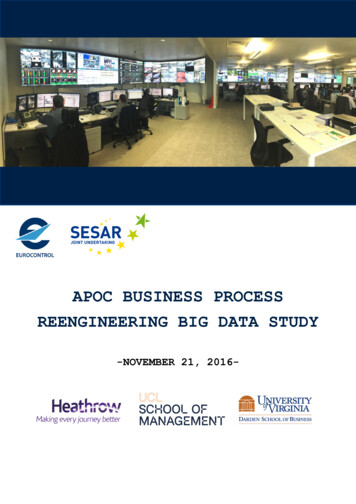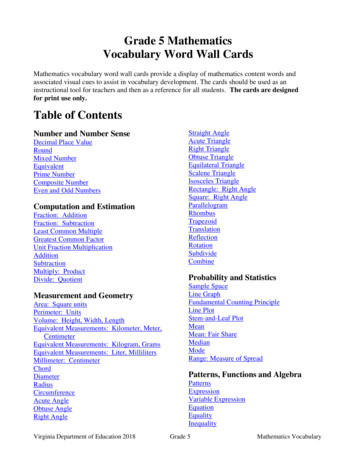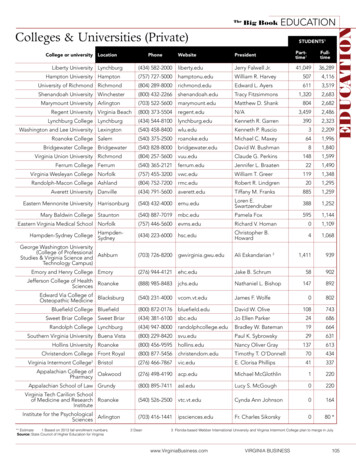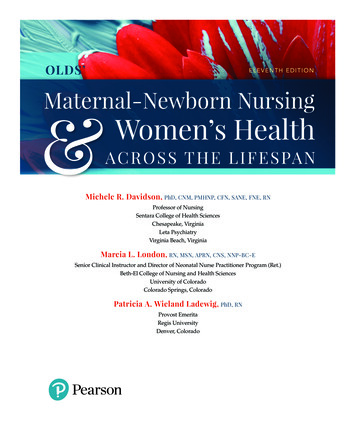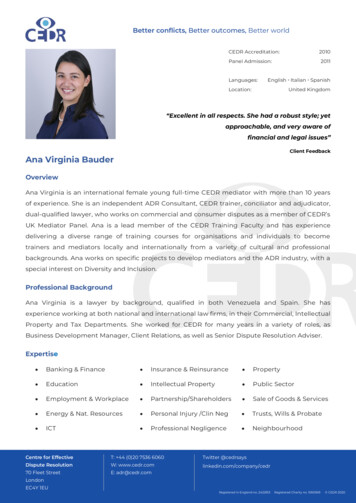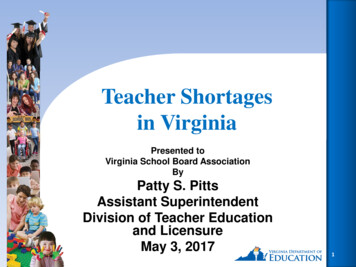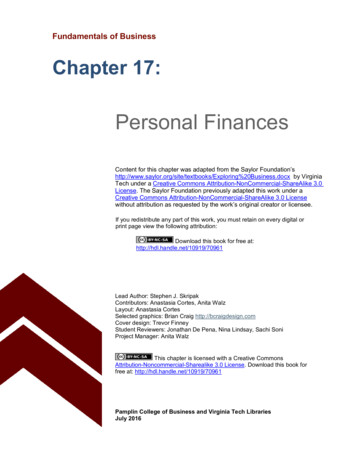
Transcription
Fundamentals of BusinessChapter 17:Personal FinancesContent for this chapter was adapted from the Saylor /Exploring%20Business.docx by VirginiaTech under a Creative Commons Attribution-NonCommercial-ShareAlike 3.0License. The Saylor Foundation previously adapted this work under aCreative Commons Attribution-NonCommercial-ShareAlike 3.0 Licensewithout attribution as requested by the work’s original creator or licensee.If you redistribute any part of this work, you must retain on every digital orprint page view the following attribution:Download this book for free at:http://hdl.handle.net/10919/70961Lead Author: Stephen J. SkripakContributors: Anastasia Cortes, Anita WalzLayout: Anastasia CortesSelected graphics: Brian Craig http://bcraigdesign.comCover design: Trevor FinneyStudent Reviewers: Jonathan De Pena, Nina Lindsay, Sachi SoniProject Manager: Anita WalzThis chapter is licensed with a Creative CommonsAttribution-Noncommercial-Sharealike 3.0 License. Download this book forfree at: http://hdl.handle.net/10919/70961Pamplin College of Business and Virginia Tech LibrariesJuly 2016
Chapter 17Personal FinancesLearning Objectives1) Develop strategies to avoid being burdened with debt.2) Explain how to manage monthly income and expenses.3) Define personal finances and financial planning.4) Explain the financial planning life cycle.5) Discuss the advantages of a college education in meetingshort- and long-term financial goals.6) Explain compound interest and the time value of money.7) Discuss the value of getting an early start on your plans forsaving.382Download this book for free at:http://hdl.handle.net/10919/70961Chapter 17
The World of Personal CreditDo you sometimes wonder where yourFigure 17.1money goes? Do you worry about how you’llpay off your student loans? Would you like tobuy a new car or even a home someday andyou’re not sure where you’ll get the money? Ifthese questions seem familiar to you, you couldbenefit from help in managing your personalfinances, which this chapter will seek toprovide.Let’s say that you’re twenty-eight andsingle. You have a good education and a goodjob—you’re pulling down 60K working with alocal accounting firm. You have 6,000 in aretirement savings account, and you carrythree credit cards. You plan to buy a condo in two or three years, and you want to take yourdream trip to the world’s hottest surfing spots within five years. Your only big worry is the factthat you’re 70,000 in debt, due to student loans, your car loan, and credit card debt. In fact,even though you’ve been gainfully employed for a total of six years now, you haven’t been ableto make a dent in that 70,000. You can afford the necessities of life and then some, butyou’ve occasionally wondered if you’re ever going to have enough income to put somethingtoward that debt.1Now let’s suppose that while browsing through a magazine in the doctor’s office, you runacross a short personal-finances self-help quiz. There are six questions:Chapter 17 383Download this book for free at:http://hdl.handle.net/10919/70961383
Figure 17.2: Financial Quiz384Download this book for free at:http://hdl.handle.net/10919/70961Chapter 17
You took the quiz and answered with a B or C to a few questions, and are therebyinformed that you’re probably jeopardizing your entire financial future.Personal-finances experts tend to utilize the types of questions on the quiz: if youanswered B or C to any of the first three questions, you have a problem with splurging; if anyquestions from four through six got a B or C, your monthly bills are too high for your income.Building a Good Credit RatingSo, you have a financial problem. According to the quick test you took, you splurge andyour bills are too high for your income. If you get in over your head and can’t make your loan orrent payments on time, you risk hurting your credit rating—your ability to borrow in the future.How do potential lenders decide whether you’re a good or bad credit risk? If you’re apoor credit risk, how does this affect your ability to borrow, or the rate of interest you have topay? Whenever you use credit, those from whom you borrow (retailers, credit cardcompanies, banks) provide information on your debt and payment habits to three nationalcredit bureaus: Equifax, Experian, and TransUnion. The credit bureaus use the information tocompile a numerical credit score, called a FICO score; it ranges from 300 to 850, with themajority of people falling in the 600–700 range. In compiling the score, the credit bureausconsider five criteria: payment history—paying your bills on time (the most important), totalamount owed, length of your credit history, amount of new credit you have, and types ofFigure 17.3: Credit score rangesChapter 17 385Download this book for free at:http://hdl.handle.net/10919/70961385
credit you use. The credit bureaus share their scoreand other information about your credit history withFigure 17.4: How to build good credit.their subscribers.2So what does this do for you? It depends. Ifyou pay your bills on time and don’t borrow tooheavily, you’d likely have a high FICO score andlenders would like you, probably giving youreasonable interest rates on the loans yourequested. But if your FICO score is low, lenderswon’t likely lend you money (or would lend it to youat high interest rates). A low FICO score can evenaffect your chances of renting an apartment orlanding a particular job. So it’s very important thatyou do everything possible to earn and maintain ahigh credit score.As a young person, though, how do youbuild a credit history that will give you a high FICOscore? Based on feedback from several financialexperts, Emily Starbuck Gerson and Jeremy Simonof CreditCards.com compiled the list in Figure 17.4 of ways students can build good credit.3If you meet the qualifications to obtain your own credit card, look for a card with a lowinterest rate and no annual fee.A Few More Words about DebtWhat should you do to turn things around—to start getting out of debt? According tomany experts, you need to take two steps:3861)Cut up your credit cards and start living on a cash-only basis.2)Do whatever you can to bring down your monthly bills.Download this book for free at:http://hdl.handle.net/10919/70961Chapter 17
Although credit cards can be an important way to build a credit rating, many peoplesimply lack the financial discipline to handle them well. If you see yourself in that statement,then moving to a pay-as-you go basis, i.e., cash or debit card only, may be for you. Be honestwith yourself; if you can’t handle credit, then don’t use it.Bringing Down Those Monthly BillsSo what can you can to bring down your monthly bills? If you want to take a gradualapproach, one financial planner suggests that you perform the following “exercises” for oneweek:4 Keep a written record of everything you spend and total it at week’s end. Keep all your ATM receipts and count up the fees. Take 100 out of the bank and don’t spend a penny more. Avoid gourmet coffee shops.You’ll probably be surprised at how much of your money can quickly become somebodyelse’s money. If, for example, you spend 3 every day for one cup of coffee at a coffee shop,you’re laying out nearly 1,100 a year just for coffee. If you use your ATM card at a bank otherthan your own, you’ll probably be charged a fee that can be ashigh as 3. The average person pays more than 60 a year inFigure 17.5: These canreally add up quickly!ATM fees. If you withdraw cash from an ATM twice a week, youcould be racking up 300 in annual fees.5 Another idea – eat outas a reward, not as a rule. A sandwich or leftovers from home canbe just as tasty and can save you 6 to 10 a day, even morethan our number for coffee! In 2013, the website DailyWorthasked three women to try to cut their spending in half. Aftertracking her spending, one participant discovered that she hadspent 175 eating out in just one week; do that for a year andyou’d spend over 9,000!6 If you think your cable bill is too high,consider alternatives like Playstation Vue or Sling. Changingchannels is a bit different, but the savings can be substantial.Chapter 17 387Download this book for free at:http://hdl.handle.net/10919/70961387
You may or may not be among the American consumers who buy thirty-five million cansof Bud Light each day, or 150,000 pounds of Starbucks coffee, or 2.4 million Burger Kinghamburgers. Yours may not be one of the 70 percent of U.S. households with an unopenedconsumer-electronics product lying around.7 Bottom line - if, at age twenty-eight, you have agood education and a good job, a 60,000 income, and a 70,000 debt—by no means animplausible scenario—there’s a very good reason why you should think hard about controllingyour debt: your level of indebtedness will be a key factor in your ability—or inability—to reachyour longer-term financial goals, such as home ownership, a dream trip, and, perhaps mostimportantly, a reasonably comfortable retirement.Financial PlanningBefore we go any further, we need to nail down a couple of key concepts. First, justwhat, exactly, do we mean by personal finances? Finance itself concerns the flow of moneyfrom one place to another, and your personal finances concern your money and what you planto do with it as it flows in and out of your possession. Essentially, then, personal finance is theapplication of financial principles to the monetary decisions that you make either for yourindividual benefit or for that of your family.Second, as we suggested earlier, monetary decisions work out much more beneficiallywhen they’re planned rather than improvised. Thus our emphasis on financial planning—theongoing process of managing your personal finances in order to meet goals that you’ve set foryourself or your family.Financial planning requires you to address several questions, some of them relativelysimple:388 What’s my annual income? How much debt do I have, and what are my monthly payments on that debt?Download this book for free at:http://hdl.handle.net/10919/70961Chapter 17
Others will require some investigation and calculation: What’s the value of my assets? How can I best budget my annual income?Still others will require some forethought and forecasting: How much wealth can I expect to accumulate during my working lifetime? How much money will I need when I retire?The Financial Planning Life CycleAnother question that you might ask yourself—and certainly would do if you worked witha professional in financial planning—is: “How will my financial plans change over the course ofmy life?” Figure 17.6 illustrates the financial life cycle of a typical individual—one whosefinancial outlook and likely outcomes are probably a lot like yours.8 As you can see, ourdiagram divides this individual’s life into three stages, each of which is characterized bydifferent life events (such as beginning a family, buying a home, planning an estate, retiring).At each stage, there are recommended changes in the focus of the individual’s financialplanning: Stage 1 focuses on building wealth. Stage 2 shifts the focus to the process of preserving and increasing wealth thatone has accumulated and continues to accumulate. In Stage 3, the focus turns to the process of living on (and, if possible, continuingto grow) one’s saved wealth after retirement.At each stage, of course, complications can set in—changes in such conditions asmarital or employment status or in the overall economic outlook, for example. Finally, as youcan also see, your financial needs will probably peak somewhere in stage 2, at approximatelyage fifty-five, or ten years before typical retirement age.Chapter 17 389Download this book for free at:http://hdl.handle.net/10919/70961389
Figure 17.6: The Financial Life CycleChoosing a CareerUntil you’re on your own and working, you’re probably living on your parents’ wealthright now. In our hypothetical life cycle, financial planning begins in the individual’s earlytwenties. If that seems like rushing things, consider a basic fact of life: this is the age at whichyou’ll be choosing your career—not only the sort of work you want to do during your primeincome-generating years, but also the kind of lifestyle you want to live. What about college?Most readers of this book, of course, have decided to go to college. If you haven’t yet decided,you need to know that college is an extremely good investment of both money and time.Figure 17.7 summarizes the findings of a study conducted by the U.S. Census Bureau.9A quick review shows that people who graduate from high school can expect to enjoy averageannual earnings about 28 percent higher than those of people who don’t, and those who go onto finish college can expect to generate 76 percent more annual income than high schoolgraduates who didn’t attend college. Over the course of the financial life cycle, families headedby those college graduates will earn about 1.6 million more10 than families headed390Download this book for free at:http://hdl.handle.net/10919/70961Chapter 17
by high school graduates. (With better access to health care—and, studies show, with betterdietary and health practices—college graduates will also live longer. And so will theirchildren.)11Figure 17.7: Average earnings by education levelPercentage increaseEducationAverage incomeHigh school dropout 28,796-High school diploma 36,83128%Associate’s degree 44,89022%Bachelor’s degree 64,84944%Advanced degree 88,18736%over previous levelWhat about the student-loan debt that so many people accumulate? For every 1 thatyou spend on your college education, you can expect to earn about 35 during the course ofyour financial life cycle.12 At that rate of return, you should be able to pay off your studentloans (unless, of course, you fail to practice reasonable financial planning).Naturally, there are exceptions to these average outcomes. You’ll find some collegegraduates stocking shelves at 7-Eleven, and you’ll find college dropouts running multibilliondollar enterprises. Microsoft cofounder Bill Gates dropped out of college after two years, asdid his founding partner, Paul Allen. Though exceptions to rules (and average outcomes)certainly can be found, they fall far short of disproving them: in entrepreneurship as in mostother walks of adult life, the better your education, the more promising your financial future.One expert in the field puts the case for the average person bluntly: educational credentials“are about being employable, becoming a legitimate candidate for a job with a future. They areabout climbing out of the dead-end job market.”13Chapter 17 391Download this book for free at:http://hdl.handle.net/10919/70961391
Time Is MoneyThe fact that you have to choose a career at an early stage in your financial life cycleisn’t the only reason that you need to start early on your financial planning. Let’s assume, forinstance, that it’s your eighteenth birthday and that on this day you take possession of 10,000that your grandparents put in trust for you. You could, of course, spend it; in particular, it wouldprobably cover the cost of flight training for a private pilot’s license—something you’ve alwayswanted but were convinced that you couldn’t afford right away. Your grandfather, of course,suggests that you put it into some kind of savings account. If you just wait until you finishcollege, he says, and if you can find a savings plan that pays 5 percent interest, you’ll have the 10,000 plus about another 2,000 for something else or to invest.The total amount you’ll have— 12,000—piques your interest. If that 10,000 could turnitself into 12,000 after sitting around for four years, what would it be worth if you actually heldon to it until you did retire—say, at age sixty-five? A quick trip to the Internet to find acompound-interest calculator informs you that, forty-seven years later, your 10,000 will havegrown to 104,345 (assuming a 5 percent interest rate). That’s not really enough for retirementon, but it would be a good start. On the other hand, what if that four years in college had paidoff the way you planned, so that once you get a good job you’re able to add, say, another 10,000 to your retirement savings account every year until age sixty-five? At that rate, you’llhave amassed a nice little nest egg of slightly more than 1.6 million.Compound InterestIn your efforts to appreciate the potential of your 10,000 to multiply itself, you haveacquainted yourself with two of the most important concepts in finance. As we’ve alreadyindicated, one is the principle of compound interest, which refers to the effect of earninginterest on your interest.Let’s say, for example, that you take your grandfather’s advice and invest your 10,000(your principal) in a savings account at an annual interest rate of 5 percent. Over the course ofthe first year, your investment will earn 500 in interest and grow to 10,500. If you now392Download this book for free at:http://hdl.handle.net/10919/70961Chapter 17
reinvest the entire 10,500 at the same 5 percent annual rate, you’ll earn another 525 ininterest, giving you a total investment at the end of year 2 of 11,025. And so forth. And that’show you can end up with 81,496.67 at age sixty-five.Time Value of MoneyYou’ve also encountered the principle of the time value of money—the principlewhereby a dollar received in the present is worth more than a dollar received in the future. Ifthere’s one thing that we’ve stressed throughout this chapter so far, it’s the fact that mostpeople prefer to consume now rather than in the future. If you borrow money from me, it’sbecause you can’t otherwise buy something that you want at the present time. If I lend it toyou, I must forego my opportunity to purchase something I want at the present time. I will do soonly if I can get some compensation for making that sacrifice, and that’s why I’m going tocharge you interest. And you’re going to pay the interest because you need the money to buywhat you want to buy now. How much interest should we agree on? In theory, it could be justenough to cover the cost of my lost opportunity, but there are, of course, other factors.Inflation, for example, will have eroded the value of my money by the time I get it back fromyou. In addition, while I would be taking no risk in loaning money to the U.S. government, I amtaking a risk in lending it to you. Our agreed-on rate will reflect such factors.14Finally, the time value of money principle also states that a dollar received today startsearning interest sooner than one received tomorrow. Let’s say, for example, that you receive 2,000 in cash gifts when you graduate from college. At age twenty-three, with your collegedegree in hand, you get a decent job and don’t have an immediate need for that 2,000. Soyou put it into an account that pays 10 percent compounded and you add another 2,000( 167 per month) to your account every year for the next eleven years.15 The blue line inFigure 17.8 graphs how much your account will earn each year and how much money you’llhave at certain ages between twenty-four and sixty-seven.As you can see, you’d have nearly 52,000 at age thirty-six and a little more than 196,000 at age fifty; at age sixty-seven, you’d be just a bit short of 1 million. The yellow linein the graph shows what you’d have if you hadn’t started saving 2,000 a year until you wereage thirty-six. As you can also see, you’d have a respectable sum at age sixty-seven—but lessthan half of what you would have accumulated by starting at age twenty-three. More important,Chapter 17 393Download this book for free at:http://hdl.handle.net/10919/70961393
even to accumulate that much, you’d have to add 2,000 per year for a total of thirty-two years,not just twelve.Here’s another way of looking at the same principle. Suppose that you’re twenty yearsold, don’t have 2,000, and don’t want to attend college full-time. You are, however, a hardworker and a conscientious saver, and one of your financial goals is to accumulate a 1 millionretirement nest egg. As a matter of fact, if you can put 33 a month into an account that pays12 percent interest compounded,16 you can have your 1 million by age sixty-seven. That is, ifyou start at age twenty. As you can see from Figure 17.9, if you wait until you’re twenty-one tostart saving, you’ll need 37 a month. If you wait until you’re thirty, you’ll have to save 109 amonth, and if you procrastinate until you’re forty, the ante goes up to 366 a month.17Unfortunately in today’s low interest rate environment, finding 10 to 12% return is not likely.Figure 17.8: The power of compound interestThe 24 year old invested 2,000 per year for twelveyears. She stopped addingmoney in, but her total stillgrew: by age 67, she hadalmost a million dollars! 1,000,000 900,000 800,000 700,000 600,000 500,000 400,000Her friend did not invest untilshe was 35. Even thoughshe invested 2000 everyyear, by the time she was67, she still had not caughtup with her wiser friend: shehad less than 500,000. 300,000 200,000 100,000Age: 2439430354045505560Download this book for free at:http://hdl.handle.net/10919/709616567Chapter 17
Nevertheless, these figures illustrate the significant benefit of saving early.The reason should be fairly obvious: a dollar saved today not only starts earning interestsooner than one saved tomorrow (or ten years from now) but also can ultimately earn a lotmore money in the long run. Starting early means in your twenties—early in stage 1 of yourfinancial life cycle. As one well-known financial advisor puts it, “If you’re in your 20s and youhaven’t yet learned how to delay gratification, your life is likely to be a constant financialstruggle.”18How to save a million dollars by age 67Suppose you want to save orso? You probably know that your branchMake your firstpayment at age:And this is what you’llhave to save eachmonthbank can open a savings account for you,20 33but interest rates on such accounts can21 37be pretty unattractive. Investing in22 42individual stocks or bonds can be risky,23 47and usually require a level of funds24 53available that most students don’t have. In25 60those cases, mutual funds can be quite26 67interesting. A mutual fund is a27 76professionally managed investment28 85program in which shareholders buy into a30 109group of diversified holdings, such as35 199stocks and bonds. Companies like40 366Vanguard and Fidelity offer a range of50 1,319investment options including indexed60 6,253invest – do you know how or where to dofunds, which track with well-knownindices such as the Standard & PoorsFigure 17.9: What does it take to save a milliondollars?500, a.k.a. the S&P 500. Minimum investment levels in such funds can actually be within thereach of many students, and the funds accept electronic transfers to make investing moreconvenient. We’ll leave a more detailed discussion of investment vehicles to your moreadvanced courses.Chapter 17 395Download this book for free at:http://hdl.handle.net/10919/70961395
Key Take-Aways1)Credit worthiness is measured by the FICO score – or credit rating –which can range from 300-850. The average ranges from 680-719.2)To maintain a satisfactory score, pay your bills on time, borrow onlywhen necessary, and pay in full whenever you do borrow.3)81% of financial planners recommend eating out less as a way toreduce your expenses.4)Personal finance is the application of financial principles to themonetary decisions that you make.5)Financial planning is the ongoing process of managing your personalfinances in order to meet your goals, which vary by stage of life.6)Time value of money is the principle that a dollar received in thepresent is worth more than a dollar received in the future due to itspotential to earn interest.7)Compound interest refers to the effect of earning interest on yourinterest. It is a powerful way to accumulate wealth.396Download this book for free at:http://hdl.handle.net/10919/70961Chapter 17
Chapter 17 Text References and ImageCreditsImage Credits: Chapter 17Figure 17.1: Brett Hondow (2015). Untitled photo of wallet. Public domain. Retrieved fold-dollar-669458/Figure 17.3: Information for graphic: Colin Robertson (2015). “Credit Score Range – Where Do You FitIn?” Thetruthaboutcreditcards.com. Retrieved from: e-range/.Figure 17.4: Information for graphic: Emily Starbuck Gerson and Jeremy M. Simon (2016). “10 WaysStudents Can Build Good Credit.” CreditCards.com. Retrieved from: -ways-students-get-good-credit-6000.phpFigure 17.5: Poolie (2008). “Chillin’ at Starbucks.” CC BY-SA 2.0. Retrieved 44Figure 17.6: Figure adapted from: Timothy J. Gallager and Joseph D. Andrews Jr. (2003). FinancialManagement: Principles and Practice, 3rd ed. Upper Saddle River, NJ: Prentice Hall. Pp. 34, 196.Figure 17.7: Table data source: The U.S. Census Bureau (2015). “PINC-03. Educational AttainmentPeople 25 Years Old and Over, by Total Money Earnings, Work Experience, Age, Race, HispanicOrigin, and Sex.” Census.gov. Retrieved from: income-poverty/cps-pinc/pinc-03.htmlReferences: Chapter 171This vignette is adapted from a series titled USA TODAY’s Financial Diet. Go s/financial-diet-digest-2005.htm and use theembedded links to follow the entire series.2Colin Robertson (2015). “Credit Score Range – Where Do You Fit In?”Thetruthaboutcreditcards.com. Retrieved from: rerange/.3Emily Starbuck Gerson and Jeremy M. Simon (2016). “10 Ways Students Can Build GoodCredit.” CreditCards.com. Retrieved from: 0-waysstudents-get-good-credit-6000.phpChapter 17 397Download this book for free at:http://hdl.handle.net/10919/70961397
4USA Today and Elissa Buie (2005). “Exercise 1: Start small, watch progress grow.” USAToday.com. Retrieved from: 2005-04-14-financialdiet-excercise1 x.htm5Mindy Fetterman (2005). “You'll be amazed once you fix the leak in your wallet.” USAToday.com. Retrieved from: 2005-04-14-financialdiet-little-things x.htm6Cynthia Ramnarace (2013). “Could you cut your spending in half?” DailyWorth.com. Retrievedfrom: t-your-spending-in-half/27Michael Arrington (2008). “Ebay Survey Says Americans Buy Crap They Don't Want.”TechCrunch.com. Retrieved from: -americansbuy-crap-they-dont-want/8See Timothy J. Gallager and Joseph D. Andrews Jr.(2003). Financial Management: Principlesand Practice, 3rd ed. Upper Saddle River, NJ: Prentice Hall. Pp. 34, 196.9The U.S. Census Bureau (2015). “PINC-03. Educational Attainment-People 25 Years Old andOver, by Total Money Earnings, Work Experience, Age, Race, Hispanic Origin, and Sex.” Census.gov.Retrieved from: /income-poverty/cps-pinc/pinc03.html10Katherine Hansen (2016). “What Good is a College Education Anyway? The Value of aCollege Education.” Quintessential Live Career. Retrieved lege-education-value11Ibid.12Ibid.13Ibid.14See Timothy J. Gallager and Joseph D. Andrews Jr.(2003). Financial Management: Principlesand Practice, 3rd ed. Upper Saddle River, NJ: Prentice Hall. Pp. 34, 196.15The 10% rate is not realistic in today’s economic market and is used for illustrative purposes16Again, this interest rate is unrealistic in today’s market and is used for illustrative purposesonly.only.17See Arthur J. Keown (2007). Personal Finance: Turning Money into Wealth, 4th ed. UpperSaddle River, NJ: Pearson Education. P. 23.18AllFinancialMatters (2006). “An Interview with Jonathan Clements – Part 2.”Allfinancialmatters.com. Retrieved from: view-withjonathan-clements-part-2/398Download this book for free at:http://hdl.handle.net/10919/70961Chapter 17
3) Define personal finances and financial planning. 4) Explain the financial planning life cycle. 5) Discuss the advantages of a college education in meeting short- and long-term financial goals. 6) Explain compound interest and the time value of money. 7) Discuss the
